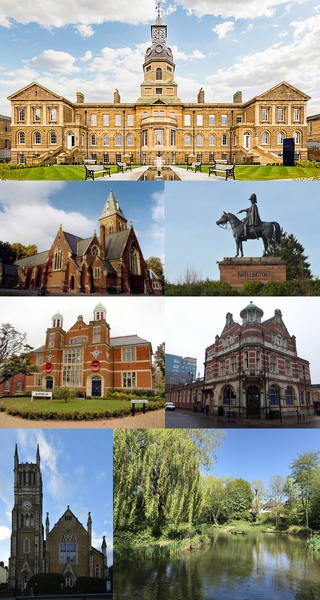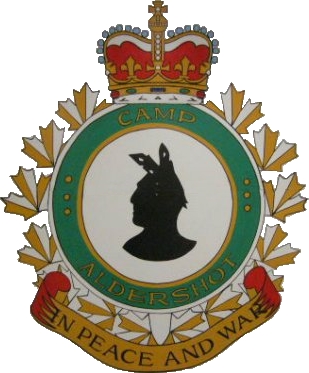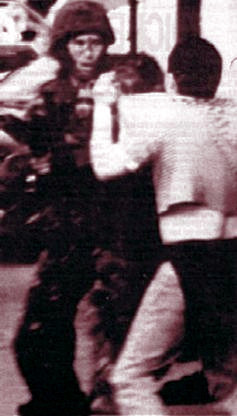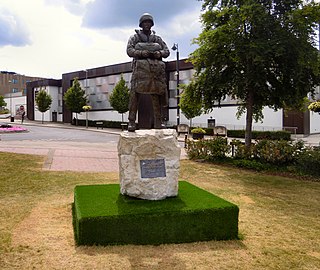
The Aldershot riot occurred on the evenings of 4 and 5 July 1945 when Canadian troops of the Canadian Army Overseas tired of waiting to be repatriated rioted in the streets of Aldershot in Hampshire, causing considerable damage to property.

The Aldershot riot occurred on the evenings of 4 and 5 July 1945 when Canadian troops of the Canadian Army Overseas tired of waiting to be repatriated rioted in the streets of Aldershot in Hampshire, causing considerable damage to property.
On Wednesday 4 July 1945 a rumour quickly spread among the 30,000 Canadian troops stationed in the area that three soldiers of the Canadian Army were in custody in Aldershot Police station. About five hundred Canadian soldiers travelled on foot from their barracks to the police station, smashing shop windows along the route. After receiving assurances that there were no Canadians in the jail, the crowd dispersed. Other rioters were simply bored with garrison life and got involved in protest at the delay in being returned home two months after the end of World War II in Europe. [1]
The rioters returned again on the evening of 5 July and gathered in Princes Gardens before marching on Union Street, where they threw bricks and stones at cars, smashed the remaining undamaged shop windows, threatened shopkeepers and broke into a brewery where they helped themselves to the stock. [1] The Canadian Military Police tried to forcibly quell the riot, which continued for more than two hours, ending around midnight. A Canadian officer who tried to send them back to their barracks told them, "You are giving Canada a bad name. Canadians are getting a fair share of boats but the shipping position is most difficult." [2] In total about £10,000 in damages was caused over the two evenings.
In 2016 four postcards sent by Canadian soldier who had been an eyewitness to the riots were published for the first time. Canadian Trooper George Karkus described the riots to his parents stating that "the boys got tired of waiting and some of them were waiting for two months." Karkus adds that 611 window frames were smashed and only £20 taken during the riots. He wrote that after the riots each Canadian camp had anti-riot squads, of which he was in one, while in Aldershot "where two roads cross there were sixteen policemen, four on each corner they worked in groups of four but by then they moved a few thousand of the worst ones out things were kind of quiet." [3]

A Cabinet meeting held on 6 July discussed the riots of the previous two days, with Prime Minister Winston Churchill demanding to know "Why could we not keep better order? Had we no British troops to call in to restore order? Where was our military police? Were we going to let these wild Canadians break up the homes of these poor innocent shopkeepers?" Churchill's military adviser Field Marshal Lord Alanbrooke replied that it would have been "only as a very last resort that I should order British troops to rough handle Canadians who are giving trouble... In such cases Canadians must deal with their own nationals. Even British Red Cap police must be kept out of it." [4]
One hundred Canadian soldiers were tried by courts-martial, and five received sentences ranging from two years with hard labour to seven years penal servitude. [1] [5] By 31 March 1946 the Canadian government had paid $41,541 to meet the costs of repairing the damage in Aldershot. Lieutenant-General John Percival "Price" Montague (1882-1966) of the Canadian Army Overseas believed that the riot's ringleaders were men who had volunteered for the Pacific Force in the expectation of being repatriated quickly calling these men "...I cannot describe otherwise than as racketeers". Of the soldiers convicted by courts-martial as a result of the riots three were Pacific volunteers. Most of the convicted men already had long records of misconduct. [6] In a gesture of forgiveness and goodwill the people of Aldershot granted "the Freedom of the Borough of Aldershot" to the Canadian Army Overseas on 26 September 1945. [7] [8]

The Conscription Crisis of 1917 was a political and military crisis in Canada during World War I. It was mainly caused by disagreement on whether men should be conscripted to fight in the war, but also brought out many issues regarding relations between French Canadians and English Canadians. Almost all French Canadians opposed conscription; they felt that they had no particular loyalty to either Britain or France. Led by Henri Bourassa, they felt their only loyalty was to Canada. English Canadians supported the war effort as they felt stronger ties to the British Empire. On January 1, 1918, the Unionist government began to enforce the Military Service Act. The Act caused 404,385 men to be liable for military service, from which 385,510 sought exemption.

Aldershot is a town in Hampshire, England. It lies on heathland in the extreme northeast corner of the county, 31 mi (50 km) southwest of London. The area is administered by Rushmoor Borough Council. The town has a population of 37,131, while the Aldershot Urban Area, a loose conurbation has a population of 243,344, making it the thirtieth-largest urban area in the UK.

The Irish Army, known simply as the Army, is the land component of the Defence Forces of Ireland. Approximately 7,300 people served in the Irish Army on a permanent basis as of May 2016, and there were 1,600 active reservists, divided into two geographically organised brigades. By late September 2020, this had reduced to 6,878 permanent army personnel.

Barracks are buildings used to accommodate military personnel. The English word originates from the 17th century via French and Italian from an old Spanish word "barraca", but today barracks are usually permanent buildings. The word may apply to separate housing blocks or to complete complexes, and the plural form often refers to a single structure and may be singular in construction.

The Royal Army Service Corps (RASC) was a corps of the British Army responsible for land, coastal and lake transport, air despatch, barracks administration, the Army Fire Service, staffing headquarters' units, supply of food, water, fuel and domestic materials such as clothing, furniture and stationery and the supply of technical and military equipment. In 1965 its functions were divided between other Corps and the RASC ceased to exist; subsequently, in 1993, they in their turn became the "Forming Corps" of the Royal Logistic Corps.
The Baltimore riot of 1968 was a period of civil unrest that lasted from April 6 to April 14, 1968, in Baltimore. The uprising included crowds filling the streets, burning and looting local businesses, and confronting the police and national guard.
Oflag VII-B was a World War II German prisoner-of-war camp for officers (Offizierlager), located in Eichstätt, Bavaria, about 100 km (62 mi) north of Munich.

Aldershot Garrison, also known as Aldershot Military Town, is a major garrison in South East England, between Aldershot and Farnborough in Hampshire. The garrison was established when the War Department bought a large area of land near the village of Aldershot, with the objective of establishing a permanent training camp for the Army. Over time, this camp grew into a military town and continues to be used by the Army to the present day. It is home to the headquarters of the Army's Regional Command, and it is also the administrative base for the 101st Logistic Brigade. The garrison plays host to around 70 military units and organisations.
On 4 and 5 March 1919 Kinmel Park in Bodelwyddan, near Abergele, North Wales, experienced two days of riots in the Canadian sector of the local military complex, Kinmel Camp. The riots are believed to have been caused by delays in repatriation and by the Canadian soldiers' resentment at being used by their British officers as forced labour.

5th Canadian Division Support Group Detachment Aldershot is a training facility for 5th Canadian Division of the Canadian Army. It is located in Kings County, Nova Scotia.
Kinmel Park Training Area is an army training ground in what was once the grounds of Kinmel Hall, near Abergele, in Conwy county borough, Wales. The camp was built in 1915 to train troops during the First World War and was later used to house troops at the end of the conflict. A riot broke out in the camp among Canadian forces in 1919, leading to the deaths of several soldiers.
The Tooreen ambush was an ambush carried out by the Irish Republican Army (IRA) on 22 October 1920, during the Irish War of Independence. It took place near Roberts Farm, Tooreen, near Ballinhassig in County Cork. The IRA ambushed two lorries of British soldiers, killing three and wounding four others. The British surrendered and their weapons and ammunition were seized by the IRA. Later that night, British soldiers went on a rampage in nearby Bandon.

The Epsom riot took place on 17 June 1919 when between 300 and 800 Canadian soldiers rioted and attacked the police station in Epsom, Surrey, England. Station Sergeant Thomas Green, a British police officer, was injured during the incident and died the following day.
The Helwan riots were protests by South African soldiers in Helwan, Egypt over their housing conditions and treatment while being repatriated at the conclusion of the Second World War. Property damage in the range of millions of Pounds sterling was caused to local businesses, but after placating the unhappy soldiers, they were repatriated to South Africa.

The 1992 Coalisland riots were a series of clashes on 12 and 17 May 1992 between local Irish nationalist civilians and British Army soldiers in the town of Coalisland, County Tyrone, Northern Ireland. The Third Battalion 1992 tour's codename was "Operation Gypsy".
Riots in Detroit, Michigan, have occurred since the city was founded in 1701. This area was settled by various ethnicities following thousands of years of indigenous history. During the colonial period, it was nominally ruled by France and Great Britain before the border was set in the early 19th century and it became part of the United States. The first riot, social unrest related to enabling fugitive slaves to escape to Canada, was recorded in 1833. Other riots were related to business protests, unions, and other issues.

The 1st Military Police Brigade is a policing formation of the British Army, which is the only one-star command of the Royal Military Police. The brigade was formed in 2014, but due to be reduced to a Colonel's command in 2022 and re-structure by 2023.

The Royal Pavilion, also known as the Queen's Pavilion, was a royal residence located at Aldershot in Hampshire. The most unpretentious of all royal residences, it was built by George Myers as a wooden structure in 1855 for Queen Victoria and Prince Albert for use by members of the Royal Family when in Aldershot to attend military reviews and other occasions. Located off the Farnborough Road opposite the former West Cavalry Barracks, nearby are the Royal Garrison Church and the Wellington Statue. It was dismantled in the early 1960s. Today the site is the location of the Royal Pavilion Office Park.

The Princes Gardens is an urban park in the town of Aldershot in Hampshire. A short walk from the town centre on a site bordered by the town's High Street, Wellington Avenue and Princes Way and opposite the Princes Hall theatre, it has been a public park since 1930. Today the park is managed by Rushmoor Borough Council.

The Levant Crisis, also known as the Damascus Crisis, the Syrian Crisis, or the Levant Confrontation, was a military confrontation that took place between British and French forces in Syria in May 1945 soon after the end of World War II in Europe. French troops had tried to quell nationalist protests in Syria at the continued occupation of the Levant by France. With heavy Syrian casualties, British Prime Minister Winston Churchill opposed French action and sent British forces into Syria from Transjordan with orders to fire on the French if necessary.